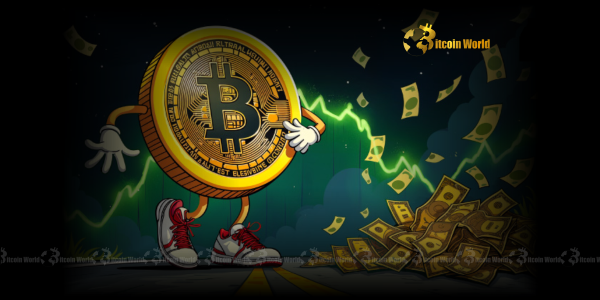BitcoinWorld

Tether USDT Freeze: A Crucial Blow Against Terrorist Financing
In a significant move that underscores the evolving landscape of digital finance and its commitment to combating illicit activities, Tether, the world’s largest stablecoin issuer, recently announced a crucial collaboration with U.S. authorities. This partnership led to a swift Tether USDT freeze of approximately $1.6 million in USDT, directly linked to Buy Cash Money and Money Transfer Company (BuyCash), a Gaza-based financial network implicated in terrorist financing. This action isn’t just about freezing funds; it’s a powerful statement about the growing maturity of the cryptocurrency space and its proactive efforts to ensure financial integrity.
The Significance of the Tether USDT Freeze: Unpacking the BuyCash Incident
The recent Tether USDT freeze of $1.6 million is far more than a routine law enforcement action; it represents a pivotal moment in the fight against financial crime within the digital asset ecosystem. BuyCash, the entity at the center of this operation, is not just any money transfer service. It has been identified as a critical node in a network facilitating terrorist financing, specifically operating out of Gaza. This connection highlights the grave real-world implications of illicit financial flows, even when they utilize digital currencies.
For years, critics have often pointed to cryptocurrencies, including stablecoins like USDT, as potential tools for nefarious activities due to their perceived anonymity or ease of transfer across borders. While the decentralized nature of blockchain technology can indeed present challenges for oversight, Tether’s latest action demonstrates a robust and growing capacity within the industry to cooperate with global law enforcement agencies. By leveraging its centralized control over USDT issuance, Tether possesses the unique ability to freeze assets on its blockchain, effectively cutting off funds to designated illicit entities.
This incident sends a clear message: the crypto world is not a lawless frontier. Instead, it is increasingly becoming a domain where transparency, accountability, and collaboration are paramount. The scale of the freeze, while significant, is less about the dollar amount and more about the precedent it sets. It reinforces the idea that even in the fast-paced world of digital assets, financial networks are subject to scrutiny, and those attempting to exploit them for illegal purposes will face consequences.
How Tether Actively Combats Financial Crime and Bolsters Cryptocurrency Security
Tether’s role in the Tether USDT freeze against BuyCash is a direct result of its evolving and robust compliance framework. As a centralized issuer of the most widely used stablecoin, Tether operates under stringent anti-money laundering (AML) and counter-terrorism financing (CTF) protocols. These protocols are designed to identify, prevent, and report suspicious activities, aligning Tether with traditional financial institutions in its commitment to global financial security.
Here’s a closer look at how Tether actively works to combat financial crime:
- Proactive Collaboration with Law Enforcement: Tether maintains an open channel of communication with global law enforcement agencies, including the U.S. Department of Justice (DOJ) and the U.S. Treasury’s Office of Foreign Assets Control (OFAC). This collaboration is not merely reactive; Tether often initiates investigations based on its internal monitoring and intelligence.
- Rigorous KYC/AML Procedures: While USDT transactions on the blockchain can be pseudonymous, the process of acquiring or redeeming USDT from Tether directly involves comprehensive Know Your Customer (KYC) and AML checks. This means that entities wishing to onboard or offboard large sums of USDT through Tether must undergo thorough identity verification.
- Transaction Monitoring and Blacklisting: Tether employs sophisticated analytics tools to monitor transactions on the blockchain. When illicit addresses are identified – often through intelligence shared by authorities or internal investigations – Tether has the technical capability to blacklist these addresses, rendering any USDT held within them unusable. This was precisely the mechanism used in the BuyCash Tether USDT freeze.
- Transparency and Reporting: Tether is committed to transparency regarding its efforts. It regularly publishes attestations of its reserves and details its cooperation with authorities, building trust and demonstrating its commitment to responsible stablecoin issuance.
This multi-faceted approach ensures that while USDT facilitates efficient global transactions, it does so within a framework designed to deter and disrupt criminal enterprises. The success of the BuyCash operation serves as a testament to the effectiveness of these measures, enhancing overall cryptocurrency security.
The Broader Impact on Cryptocurrency Security and Trust
Beyond the immediate financial implications, the Tether USDT freeze carries significant weight for the entire cryptocurrency industry. For years, one of the biggest hurdles to mainstream adoption of digital assets has been the perception that they are havens for illicit activities. Actions like Tether’s directly challenge this narrative, fostering greater trust and legitimacy for the space as a whole.
Consider the following impacts:
- Enhanced Regulatory Confidence: Governments and financial regulators worldwide are grappling with how to oversee the rapidly evolving crypto market. When leading industry players like Tether demonstrate a willingness and capability to enforce financial integrity, it provides regulators with greater confidence that the sector can self-regulate and cooperate effectively. This could pave the way for more nuanced and supportive regulatory frameworks, rather than blanket prohibitions.
- Increased User Trust: For everyday users and institutional investors, the knowledge that stablecoin issuers are actively working to prevent financial crime builds confidence. It suggests that their assets are not inadvertently supporting illicit networks and that the underlying infrastructure is robust against misuse. This heightened trust is crucial for the continued growth and stability of the market.
- Differentiating Legitimate Use: By isolating and disrupting illicit actors, Tether’s actions help to clearly distinguish between the legitimate, innovative applications of blockchain technology and its potential for abuse. This distinction is vital for public perception and for attracting further investment into the beneficial aspects of crypto.
- Setting an Industry Standard: Tether’s proactive approach sets a precedent for other stablecoin issuers and centralized cryptocurrency entities. It encourages a collective responsibility within the industry to uphold high standards of compliance and security, leading to a safer and more resilient digital financial ecosystem. This collective effort significantly contributes to overall cryptocurrency security.
Ultimately, such decisive actions help to mature the cryptocurrency market, moving it from a niche, often misunderstood, domain to a recognized and respected component of the global financial system. This evolution is essential for crypto to fulfill its potential as a transformative technology.
Navigating Challenges and Enhancing Stablecoin Oversight
While the Tether USDT freeze is a significant victory, the fight against financial crime in the digital realm is ongoing and presents its own set of complex challenges. The very nature of decentralized networks and global reach of cryptocurrencies means that oversight requires constant innovation and international cooperation.
What are some of these challenges, and how can the industry and regulators work together to enhance stablecoin oversight?
- Global Coordination: Financial crimes often transcend national borders, making global coordination among law enforcement agencies and crypto companies absolutely critical. Developing standardized protocols for information sharing and asset freezing across different jurisdictions remains a complex task.
- Balancing Privacy and Security: A core tenet of blockchain technology is privacy. However, combating illicit finance often requires some level of transparency or the ability to trace transactions. Finding the right balance between user privacy and the imperative for security and law enforcement access is a delicate but necessary act.
- Evolving Threat Landscape: Criminals are constantly adapting their methods, seeking new ways to exploit vulnerabilities. This necessitates continuous investment in advanced analytics, artificial intelligence, and blockchain forensics to stay ahead of sophisticated schemes.
- Regulatory Clarity: The absence of consistent and clear regulatory frameworks for stablecoins across different countries can create regulatory arbitrage opportunities, potentially exploited by bad actors. Comprehensive and harmonized regulations, such as those being developed in the EU (MiCA) and discussed in the U.S., are vital for providing clarity and enabling more effective enforcement.
The path forward involves a collaborative ecosystem where technology providers, stablecoin issuers, law enforcement, and policymakers work in tandem. This means not only responding to incidents like the BuyCash Tether USDT freeze but also proactively building frameworks that anticipate and mitigate future threats, ensuring the long-term integrity and cryptocurrency security of the digital asset space.
Actionable Insights for a Safer Crypto Journey
As the cryptocurrency market matures and efforts to combat financial crime intensify, it’s important for every participant to understand how they can contribute to a safer ecosystem. While entities like Tether are working on a macro level, individual actions collectively strengthen cryptocurrency security.
Here are some actionable insights for users and the broader industry:
- Do Your Due Diligence: Before engaging with any crypto platform, exchange, or service, thoroughly research its reputation, security measures, and compliance with regulations. Look for clear KYC/AML policies.
- Understand Stablecoin Mechanisms: Familiarize yourself with how stablecoins are backed and managed. While Tether has demonstrated its ability to freeze funds, understanding the centralized nature of stablecoin issuance is key.
- Secure Your Wallets: Implement strong security practices for your personal crypto wallets. Use strong, unique passwords, enable two-factor authentication (2FA), and consider hardware wallets for significant holdings. Be wary of phishing attempts and suspicious links.
- Report Suspicious Activity: If you encounter any activity that seems fraudulent or linked to illicit finance, report it to the relevant authorities and the platform involved. Your vigilance can make a difference.
- Stay Informed About Regulations: Keep abreast of regulatory developments in your region and globally. Understanding the legal landscape helps you navigate the crypto space responsibly and securely.
- Support Responsible Projects: Patronize projects and platforms that prioritize compliance, transparency, and user security. This encourages the industry to adopt best practices.
By adopting these practices, individuals become active participants in building a more secure and trustworthy digital financial future. The Tether USDT freeze is a powerful reminder that security is a shared responsibility.
The proactive Tether USDT freeze of $1.6 million linked to the BuyCash terrorist financing network marks a truly significant milestone for the cryptocurrency industry. It unequivocally demonstrates that stablecoin issuers are not only willing but also highly capable of collaborating with global authorities to combat illicit finance. This action bolsters the credibility of digital assets, paving the way for greater regulatory confidence and wider mainstream adoption. While challenges persist in the complex landscape of global financial crime, Tether’s decisive move reinforces the collective commitment to building a secure, transparent, and legitimate future for cryptocurrencies. It’s a powerful testament to the fact that innovation can indeed thrive alongside robust security measures, ensuring a safer digital economy for everyone.
Frequently Asked Questions (FAQs)
1. What is the significance of Tether freezing $1.6 million in USDT?
The Tether USDT freeze of $1.6 million linked to BuyCash, a Gaza-based network involved in terrorist financing, is significant because it demonstrates a leading stablecoin issuer’s capability and willingness to actively combat illicit financial activities. It reinforces the idea that cryptocurrencies are not beyond the reach of law enforcement and helps build trust in the digital asset ecosystem.
2. How does Tether identify and freeze illicit funds?
Tether employs a robust compliance framework that includes proactive collaboration with law enforcement, rigorous KYC/AML procedures for direct users, and sophisticated transaction monitoring tools. When illicit addresses are identified, either through internal investigations or intelligence from authorities, Tether has the technical ability to blacklist these addresses, making the USDT held within them unusable.
3. Is this the first time Tether has frozen funds?
No, Tether has a history of cooperating with law enforcement and freezing funds associated with illicit activities. This particular Tether USDT freeze, however, highlights a significant collaboration against a specific terrorist financing network, underscoring the growing effectiveness of these partnerships.
4. How does this action impact the broader cryptocurrency security landscape?
This action significantly enhances cryptocurrency security and trust. It signals to regulators that the industry is maturing and capable of self-policing, potentially leading to more favorable regulatory environments. It also assures users that major stablecoin issuers are committed to preventing their platforms from being used for crime, fostering greater confidence in the legitimate use of digital assets.
5. What are stablecoins, and why are they relevant in financial crime?
Stablecoins are cryptocurrencies designed to maintain a stable value, often pegged to fiat currencies like the U.S. dollar (e.g., USDT). Their stability and ease of transfer across borders can make them attractive for legitimate transactions, but also for illicit activities if not properly regulated. Tether’s actions demonstrate how a centralized stablecoin issuer can mitigate these risks.
Did you find this article insightful? Share it with your network on social media to spread awareness about the crucial steps being taken to enhance cryptocurrency security and combat financial crime!
To learn more about the latest crypto market trends, explore our article on key developments shaping Bitcoin’s institutional adoption.
This post Tether USDT Freeze: A Crucial Blow Against Terrorist Financing first appeared on BitcoinWorld and is written by Editorial Team





